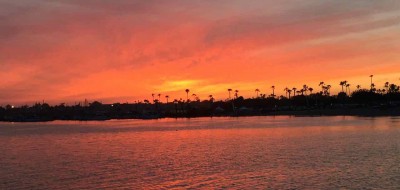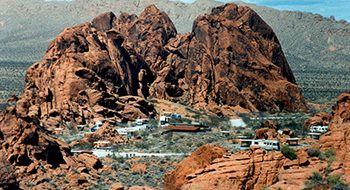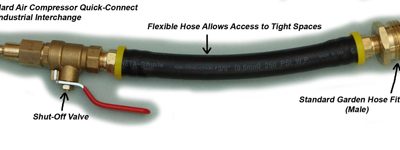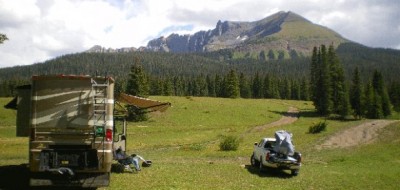
By Bob Difley
Water. A natural resource without which we would all die, or at least have to leave our pristine-out-in-the-boonies-perfect-forested-by-a-stream-full-of-trout-while-elk-graze-nearby campsite. It usually turns out that the great campsite you found deep in the woods is also the one you don’t want to pack up and leave to replenish, restore, and the other chores necessary for boondocking. And potable (drinking) water is arguably the weak link in the boondockers chain.
If you never boondock for more than a day or two water does not occupy much of your thinking time, not even when you turn on the tap and clean, pure water runs into your glass. But as boondockers we usually find ourselves conserving every drop, reluctant to waste any, dreading the water pump’s dry sucking sound as the water tank reaches empty.
Here are some tips to conserve that precious resource so you might squeeze out another day in your idyllic campsite.
- Fill your water tank to the brim just before heading to your boondocking campsite.
- Collect running water when waiting for the hot to come to use for rinsing dishes, cooking pasta, flushing toilet, etc.
- When showering: reduce flow, wet down, turn off, soap up, turn on, rinse off. The typical Navy shower.
- Rinse dishes in plastic tub of saved water rather than under running faucet.
- Turn off faucet when brushing teeth and washing hands and face, then turn on to rinse.
You can also increase your water supply in these ways:
- Carry one or two 6-gallon Jerry jugs of water to replenish your tank.
- Stow the empty Jerry jugs in your tow or toad so that if you drive it out for supplies or exploring (easier than moving the whole rig) you can refill them at any water source you find.
- You can also buy a larger water bladder (Camping world, West Marine) for driving to a water source, then use a small water pump to transfer the water to your rig’s water tank.
- Use a Sun Shower filled with stream water and placed in the sun to heat. Hang from a tree and use for showers.
- Use a water filter to make stream or lake water safe to drink and use for cooking.






Carl Strohmeyer
Great Article!
We have mostly “Dry-Camped” with our family in our Class C motorhome over the last 18 years.
I uses a collapsible 5 gallon camping water container that I placed a 250 gph aquarium pump inside to transfer water either from a spigot or water bleached or boiled from a clean stream to keep up with water. I power this AC pump with either my generator or the inverter that I built into my RV
We always use nearby vault toilets to keep from filling our black tank and using the water needed for each flush.
For cleaning we keep wet wipes and hand sanitizer strategically placed in many location in our RV.
Thanks again for this excellent article, I always enjoy reading tips about boondocking!
Bob Difley
Dan asks, “What are good ways to manage gray (and black) water without driving the rig to a dump station?”
I will be posting today on that very subject under the title: “The gray water dilemma”
Dan Strickland
Tips are all good, plus other techniques such as collecting rain water or micron filtering river or lake water for washing or sub-micron for drinking.
However, I find that my biggest limitation is capacity of the gray water tank. It is illegal to dump gray water on the ground, although I know that it is done.
What are good ways to manage gray (and black) water without driving the rig to a dump station?
Boyd Martin
Here are some good suggestions — http://www.scribd.com/doc/2236103/How-to-Collect-Survival-Water — I’ve used some of these while boondocking, and also have a dew and fog collector–basically an inverted cone of a square yard of plastic that drains into a jar. You can get a half-gallon of drinking water a day this way.
Ted Kremer
To fill the fresh water tank from an external jug, place the “siphon” hose from the winterizing valve into the jug. Turn the winterizing valve to the winterize position. Turn the city/normal valve on the fresh water tank to the city position & turn on the water pump. The water from the jug will go into the fresh water tank.
Geoffrey Pruett
We dry camp a lot, mostly in the milder months and have found two helps to extend our stays up to four days for 2 without leaving our spot.
First is using the folding plastic water bags in both 2.5 and 5 gal size, smaller is better if there is a distance to supply as they get heavy in a few feet. and a small electric pump to avoid standing there in the spray while filling the tank.
The second is an old trick from early class C days, joining the black and gray water tanks at about the 75% point with a range extender coupling so the load is equalized when near filled. This does mean treating both tanks with chemical so may not be for everyone. Our small A will hold two full fresh water fills before dumping this way. The range extender is available from most trailer parts sources and you should look at clearances carefully before starting the project!
Barry S
My experience is that the limiting factor is just that: running out of gray and black water tank space. Of course, our little Trek tanks hold 80 gallons of fresh water, and 40/40 gallons for black and gray.
We usually get the large jugs of fresh water at Walmart for drinking, then reuse the containers by filling them up at home before any subsequent trips. But, again, our concern is filling up the black and gray water tanks first. We don’t dump gray water on the ground, although I have no idea if gray water would harm the environment.
We haul just enough water for on-the-road use of the toilet, then fill the tank to overflowing just before we get to the boondock destination. We try to keep the tanks empty to reduce fishtailing.
We also use Jerry X Shea’s method of conserving water. We sometimes heat water for the Navy “shower” on the stove, then pour it into the 1-gallon bowl, set it on the shower floor and use it for the sponge bath. So….two gallons per day for bathing for two people.
We try to find a boondocking spot reasonably close to a dump site so that if we wish to stay longer, we can dump the gray/black water and refill the fresh water, then return for another couple of weeks. Before returning home, we dump the gray/black tanks and keep just enough fresh water to use the toilet on the way home, but this is nothing new.
Old Gray
A caveat (probably unnecessary for all you knowledgeable boondockers – but…) if you are filling water tanks from a lake or stream, your filter must be able to take out all those nasty organisms like cysts, bacteria, protozoa and giardia that cause really nasty infections. Make sure the filter will take out everything to 0.3 microns. Follow Bob’s link for a water filter that should keep you safe.
Bob and Julie
Very good Article! We do love to boondock for months at a time. But we don’t like to suffer much. So our routine includes a trip to “civilization ” once a week. for provisions. We had a tank made for the back of our pickup. Half for fresh water and half for grey water. A tank buddy pumps the grey water up to the gw tank in the pickup and off we go. Upon return, with groceries and fresh water, an onboard pump plugs into the trailer socket and pumps fresh water into the fw tank of the 5th wheel trailer. We cook, drink and brush our teeth with RO water from the grocery store.
Jerry X Shea
Great article Bob. This is one day of boondocking for us. Get up and go for a run and enjoy nature. Then take a shower bu capture those first 10 sec. of cold water in the shower (into a pot) then take that “Navy” shower. That water in the pot is used to brush our teeth, wash our face (ok so it is cold – get over it) and any other needs we may have for water that day. At night we use it to boil pasta (do not add anything to the water) then dump that hot water into a tub (not your sink, ust a small wash tub) and add some soap and wash your dishes, then use that water to flush the tolet – that would be the toliet that you did not flush all day (yes folks – its ok – just lower the lid). Bottom line is about 1 gal of water can go a long way when you boondock. If there are bathrooms near by, use them. You will really be amazed at how long you can boondock if you just “think” of how you use water and your holding tanks.
Pete Holden
I carry a 55 gal. water tank in the back of my truck and siphon water to my trailer’s tank so don’t need a pump. The problem siphons face is that the fresh water fill port on the RV is typically higher than the tank in the truck. So, I siphon the water using a garden hose attached to the drain valve under the trailer. To make the connection possible, though, you’ll have to get short lengths of plastic tubing at Lowe’s or Home Depot to step down from the larger diameter garden hose. A long run of the smaller diameter tubing might have so much flow resistance that it won’t ever fill. A couple of caveats… Siphoning is a slow process; figure a half hour or so to transfer 40 gallons. Also, try to get a water tank for your truck with a hose fitting drain at the bottom of the tank. Mine, unfortunately, requires me to suck on the hose to start the siphon. The first time I did it I passed out. It must have been a blood pressure thing.
Carl C
Good stuff. I spent the winter of 2009/2010 in the Adirondack Mountains in my 35′ MH. While I had a 30Amp hookup, I did not have a water supply. My 80 Gallon tank would last me two weeks at a time. However, I was able to take showers in a permanent structure (community shower). I found that my water supply could last up to three weeks if I stretched it but my black and gray water tanks would only last two. I should mention that I’m the only one living in my RV. My tanks are 80G Fresh and 40G each for black/gray water tanks. So, YMMV with your set up.
My biggest concern was keeping my tanks from freezing. My water lines froze one night for about 3 to 4 hours. I was quick to figure it out during a 2am bathroom break. Outside temp: a balmy -20°F!
Good times!